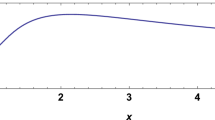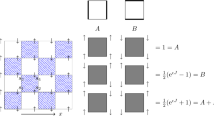Abstract
We demonstrate the utility of effective Hamilonians for studying extended correlated systems, such as quantum spin systems. After defining local relevant degrees of freedom, the numerical contractor renormalization (CORE) method is applied in two steps (i) building an effective Hamiltonian with longer ranged interactions up to a certain cut-off using the CORE algorithm and (ii) solving this new model numerically on finite clusters by exact diagonalization and performing finite-size extrapolations to obtain results in the thermodynamic limit. This approach, giving complementary information to analytical treatments of the CORE Hamiltonian, can be used as a semi-quantitative numerical method. For ladder type geometries, we explicitly check the accuracy of the effective models by increasing the range of the effective interactions until reaching convergence. Our results in the perturbative regime and also away from it are in good agreement with previously established results. In two dimensions we consider the plaquette lattice and the kagomé lattice as non-trivial test cases for the numerical CORE method. As it becomes more difficult to extend the range of the effective interactions in two dimensions, we propose diagnostic tools (such as the density matrix of the local building block) to ascertain the validity of the basis truncation. On the plaquette lattice we have an excellent description of the system in both the disordered and the ordered phases, thereby showing that the CORE method is able to resolve quantum phase transitions. On the kagomé lattice we find that the previously proposed twofold degenerate S=1/2 basis can account for a large number of phenomena of the spin 1/2 kagomé system. In general, we are able to simulate system sizes which correspond to an 8× 8 lattice for the plaquette lattice or a 48-site kagomé lattice, which are beyond the possibilities of a standard exact diagonalization approach.
Similar content being viewed by others
References
Al Hajj M, Guihéry N, Malrieu J-P, Wind P (2004). Phys Rev B 70:094415
Morningstar CJ, Weinstein M (1994). Phys Rev Lett 73:1873
Morningstar CJ, Weinstein M (1996). Phys Rev D 54:4131
Weinstein M (2001). Phys Rev B 63:174421
Altman E, Auerbach A (2002). Phys Rev B 65:104508
Berg E, Altman E, Auerbach A (2003). Phys Rev Lett 90:147204
Piekarewicz J, Shepard JR (1997). Phys Rev B 56:5366
Piekarewicz J, Shepard JR (1998). Phys Rev B 57:10260
Capponi S, Poilblanc D (2002). Phys Rev B 66:180503(R)
Malrieu J-P, Guihéry N (2001). Phys Rev B 63:085110
Capponi S, Läuchli A, Mambrini M (2004). Phys Rev B
Laughlin RB, Pines D (2000). Proc Nat Acad Sci 97:28 (see the discussion and references).
Dagotto E, Rice TM (1996). Science 271:618 and references therein
Barnes T, Dagotto E, Riera J, Swanson ES (1993). Phys Rev B 47:3196
White SR, Noack RM, Scalapino DJ (1994). Phys Rev Lett 73:886
Frischmuth B, Ammon B, Troyer M (1996). Phys Rev B 54: R3714
Greven M, Birgeneau RJ, Wiese U-J (1996). Phys Rev Lett 77:1865
Kawano K, Takahashi M (1997). J Phys Soc Jpn 66:4001
Cabra DC, Honecker A, Pujol P (1998). Phys Rev B 58:6241
Martin T, Montambaux G, Trân Thanh Vân J (eds). (1996). In: Proceedings of the XXXIst Rencontres de Moriond, Frontières, Gif-sur-Yvette, France (cond-mat/9605075).
Lieb E, Schultz T, Mattis D (1961). Ann Phys 16:407
Affleck I (1988). Phys Rev B 37:5186
Koga A, Kumada S, Kawakami N (1999). J Phys Soc Jpn 68:642
Koga A, Kumada S, Kawakami N (1999). J Phys Soc Jpn 68:2373
Läuchli A, Wessel S, Sigrist M (2002). Phys Rev B 66:014401
Voigt A (2002). Comput Phys Commun 146:125
Leung PW, Elser V (1993). Phys Rev B 47:5459
Lecheminant P, Bernu B, Lhuillier C, Pierre L, Sindzingre P (1997). Phys Rev B 56:2521
Waldtmann C, Everts H-U, Bernu B, Lhuillier C, Sindzingre P, Lecheminant P, Pierre L (1998). Eur Phys J B 2:501
Mila F (1998). Phys Rev Lett 81:2356
Mambrini M, Mila F (2000). Eur Phys J B 17:651
Subrahmanyam V (1995). Phys Rev B 52:1133
Raghu C, Rudra I, Ramasesha S, Sen D (2000). Phys Rev B 62:9484
Bernu B, Lhuillier C, Pierre L (1992). Phys Rev Lett 69:2590
Sindzingre P, Lhuillier C, Fouet JB (2003). Int J Mod Phys B 17:5031 (cond-mat/0110283)
Calandra M, Sorella S (2000). Phys Rev B 61:R11894
Capriotti L (2001). Int J Mod Phys B 15:1799
Limot L, Mendels P, Collin G, Mondelli C, Ouladdiaf B, Mutka H, Blanchard N, M. Mekata M (2002). Phys Rev B 65:144447 and references therein
Budnik R, Auerbach A (2004). Phys Rev Lett 93:187205
Budnik R, M.Sc. thesis, Technion, Haifa (2004).




